Last time I checked in, I was about to try to do… something… about the enraged “noble” Pokémon, Kleavor, the Pearl Clan’s “lord of the woods.” Professor Laventon’s plan is to leverage the player character’s incredible skill at throwing $#!t by mashing some of Kleavor’s favourite foods into throwable clumps, which will in some way achieve something good, probably.

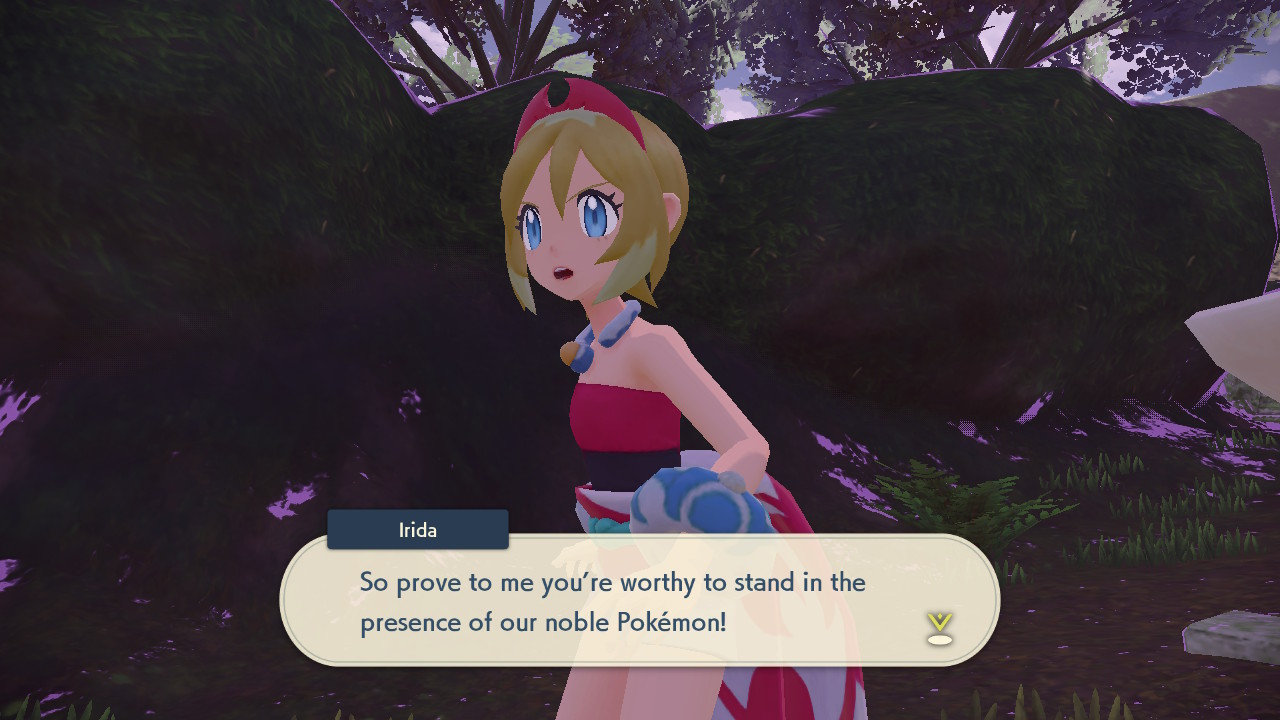
Irida is, understandably, a bit suspicious of the settler community, especially given our habit of stuffing Pokémon into tiny space-confining balls. She demands that we battle her Glaceon to prove our worth before she’ll trust us with subduing her clan’s unique and sacred totemic Pokémon. Fortunately this isn’t very difficult.
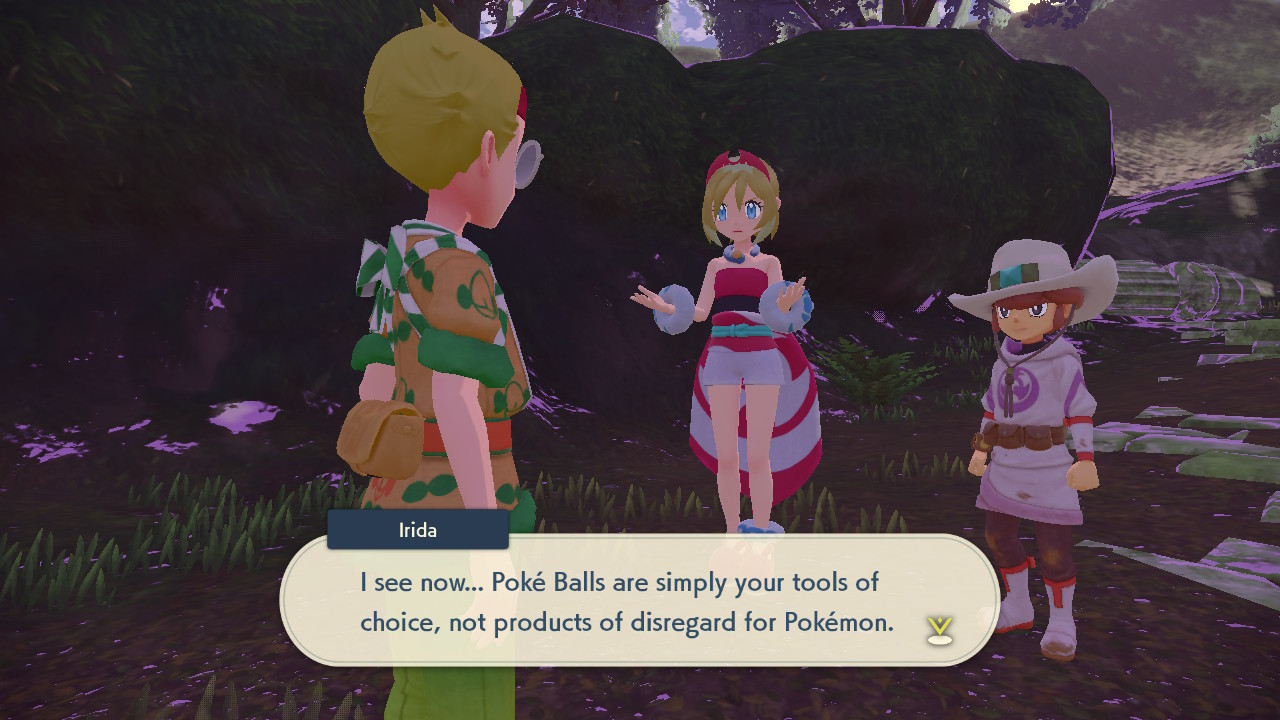

Irida and Lian help us gather the food Kleavor likes and package them into little balls, which Irida for some reason dubs “balms.” That’s… not really what the word “balm” means, but I guess they are intended to soothe Kleavor, and… I dunno, maybe we’re speaking the settlers’ language and Irida isn’t 100% fluent; I’ll give her a pass if that’s the case. Anyway. Lian uses a prayer to summon Kleavor, and it’s time for $#!t to get real.
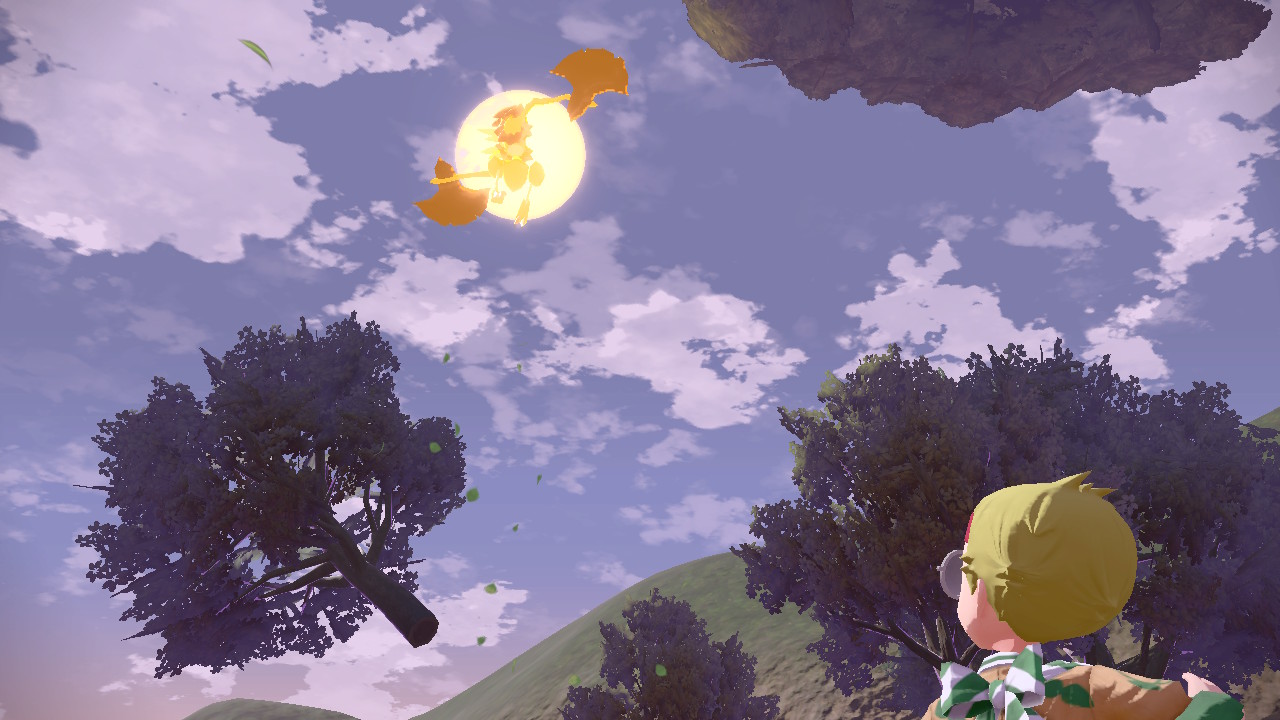
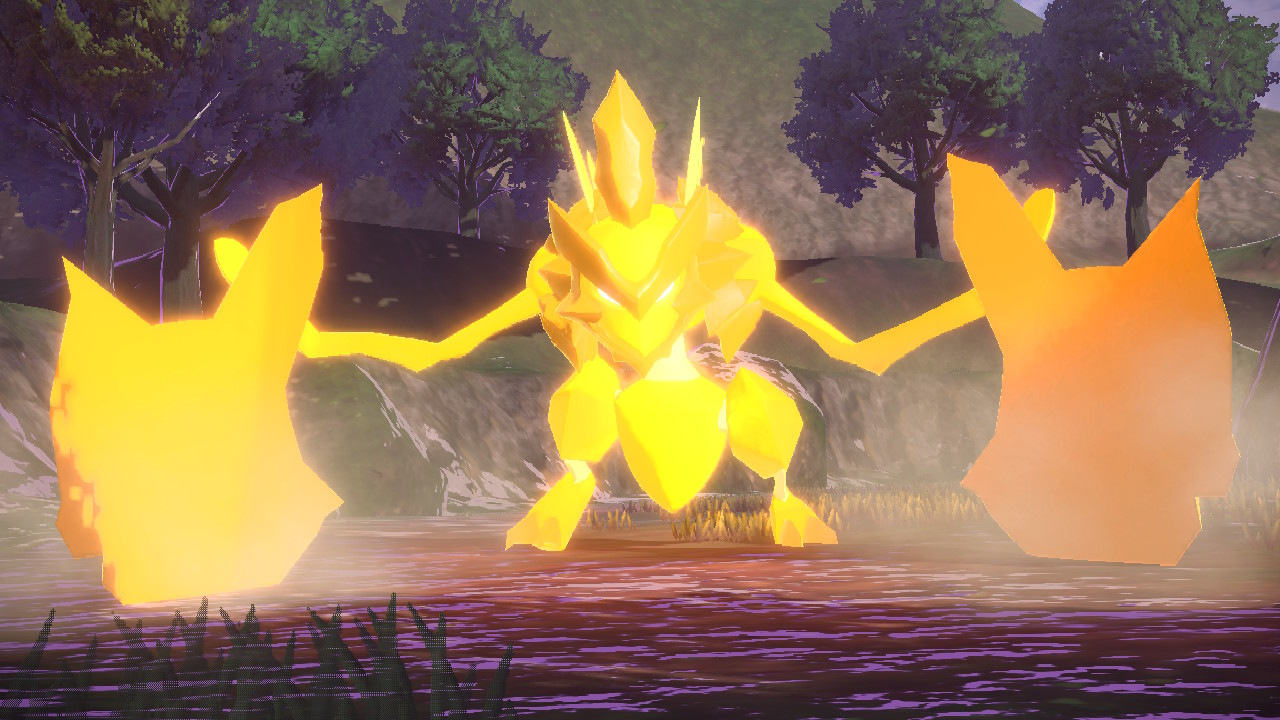
Fighting an enraged noble Pokémon isn’t like a normal battle. He has a big gold health bar that represents the supernatural rage he’s experiencing, and you can whittle it down by throwing balms at him, just like throwing objects at other wild Pokémon (except that you have an unlimited supply of balms and don’t need to craft them). Like other aggressive Pokémon out there in the game world, Kleavor will actively try to murder your character and you need to dodge around his moves (incidentally, Irida and Lian use masculine pronouns for Kleavor, so I’m following them on that). It’s worse than that, though: Kleavor is so powerful that your own Pokémon can’t actually fight him at all unless you wait for an opening. You can only enter a normal battle screen against Kleavor if he’s been dazed by charging into something (memories here of the 90s action games I played as a kid). Once you’re in a battle, even though he’s theoretically only level 18, Kleavor is punishingly strong and can easily chew through two or three of your Pokémon on his own. Even if you defeat him in battle, you haven’t really “defeated” him, but it does stun him for a while, putting him in a state where your balms will be more effective. This creates a little cycle that combines traditional Pokémon battles with Legends’ action game mechanics: dodge and evade, challenge to battle, throw balms, repeat (you can also open your item menu to patch up your team between engagements, which is good, because Kleavor is totally capable of taking out an entire squad over the course of two or three battles).

This is Legends’ attempt (potentially its first of multiple attempts?) at making a battle with one very powerful Pokémon interesting – a perennial struggle for earlier games, where legendary Pokémon tend to be anticlimactic unless the game crafts a specific solution, like making Reshiram or Zekrom part of N’s team in Black and White or having Eternatus be a raid battle alongside Hop and the legendary wolves in Sword and Shield. I like the combination of Pokémon’s traditional turn-based JRPG battles with the real-time action, and I can see how it leaves room for confrontations with different enraged noble Pokémon to play out differently, if they have different attack patterns or if the battle areas have different features. I think I would need to see that variation before I could wholeheartedly say “this is great!” but for the first fight of its kind, introducing the player to how these battles are going to go down, this seems good to me.


Anyway, once we’ve thrown enough food at him, Kleavor fµ¢£in’ explodes or something and returns to normal, because he recognises that our determination to feed him snacks is unstoppable (the whole logic of “throw food until the crazy axe-mantis calms down and decides it likes you” feels a bit tenuous to me, but hey, it worked; I’m not going to complain). Lian has doubts about whether it was right to interfere with what might have been the will of “Almighty Sinnoh” – after all, the lightning that apparently drove Kleavor into a frenzy came from the swirly vortex of doom – but Irida seems to think we’ve done the right thing. I am, of course, intensely suspicious of the swirly vortex of doom and happy to thwart its plans in any way I can.


Both Wyrdeer and Kleavor have rewarded us with ancient Plates, the magical items that (in the traditional games, at least) allow Arceus to change its type, as well as letting other Pokémon boost the power of the associated attack types. Legends doesn’t allow Pokémon to hold items, so at the moment they’re no good to us, but they seem to be vitally interesting to this guy, Volo, who is part of a merchant organisation called the Ginkgo Guild. A couple of their members hang out in town and mostly sell rare crafting ingredients. It’s not clear to me what their deal is, whether they’re a part of the indigenous population that’s independent from both the Diamond and Pearl Clans, or part of an earlier wave of foreign explorers who were only interested in trade rather than permanent settlement. In any case, the Plates appear to be a personal interest of Volo’s, not a priority for the whole guild.
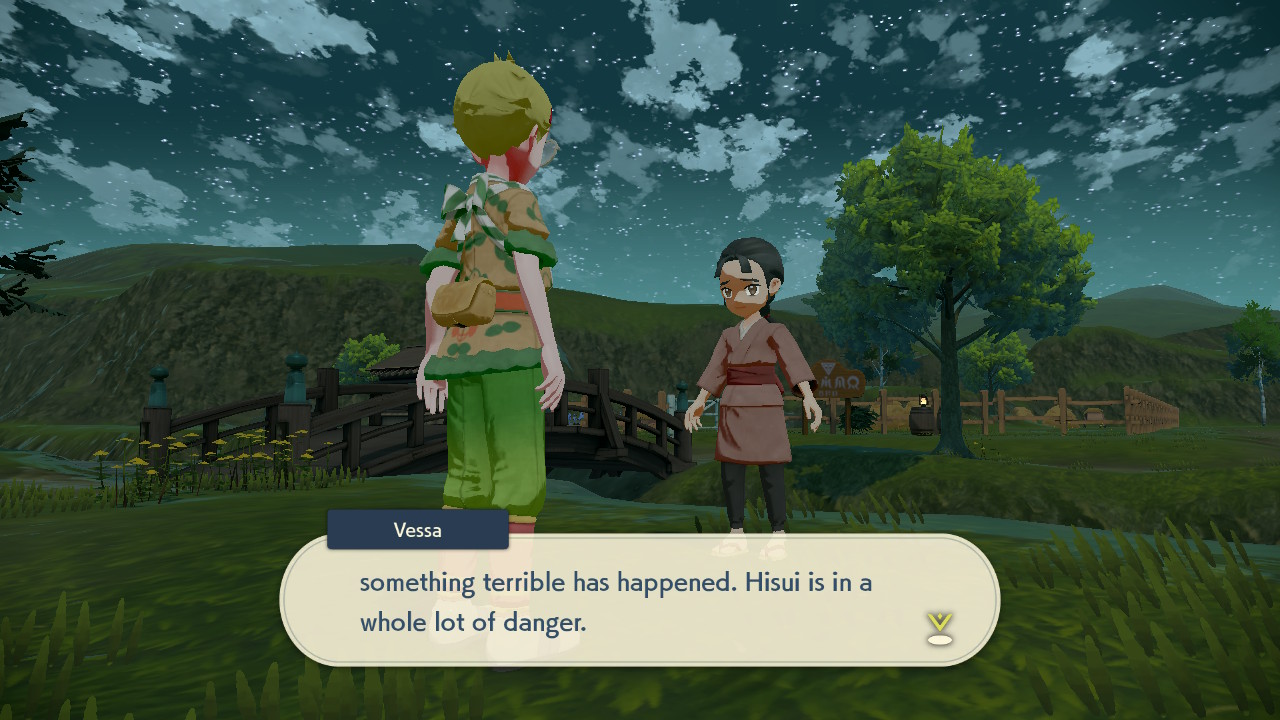
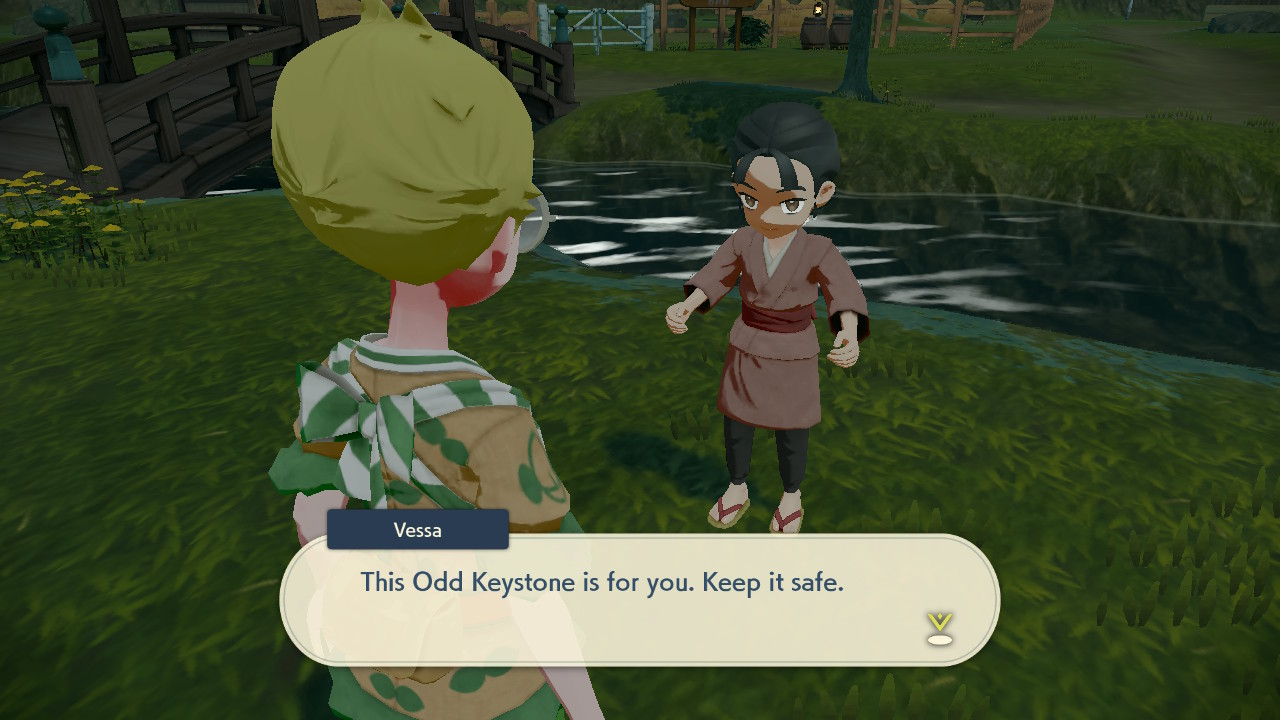
Every open-world game needs a nirnroot quest, right? In Legends’ case, we receive this from a mysterious girl called Vessa, who is worried about a terrible ancient evil being unleashed upon Hisui and wants us to collect 107 fiery purple “wisps” scattered around the region. She gives us an Odd Keystone to aid in this mission, which hints that this quest has something to do with Spiritomb (the 107 wisps are also a clue, because the number 108 shows up a lot when you’re dealing with Spiritomb). I can see two strong possibilities here: either we’re gathering the wisps to re-imprison the 108 evil souls that make up Spiritomb, or Vessa is deceiving us and we’re gathering the wisps to allow Spiritomb to be reborn and begin its cataclysmic reign of terror. Two equally worthwhile goals that I am equally happy to pursue!
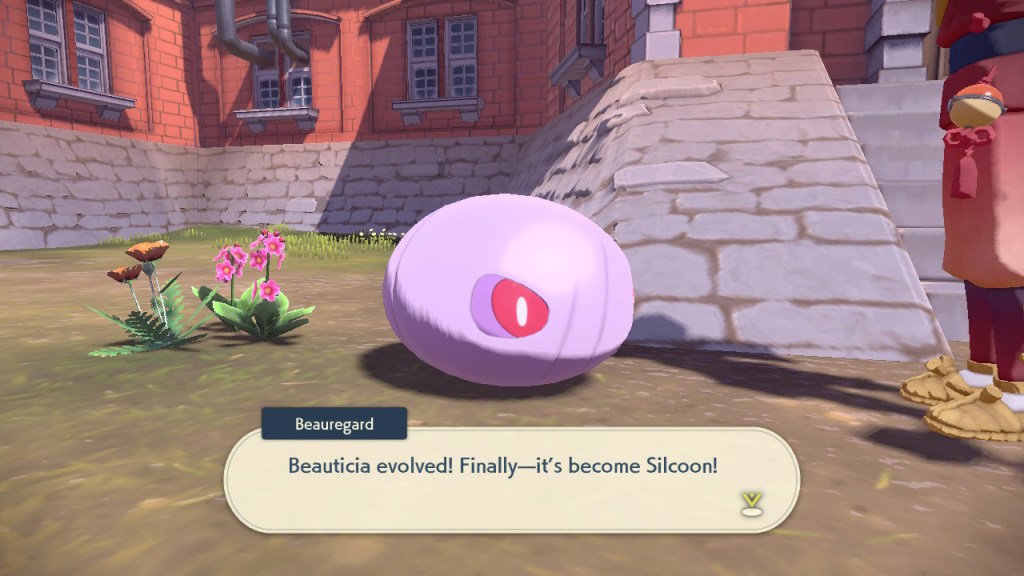
that’s not a Silcoon, Beauregard you dumb piece of $#!t
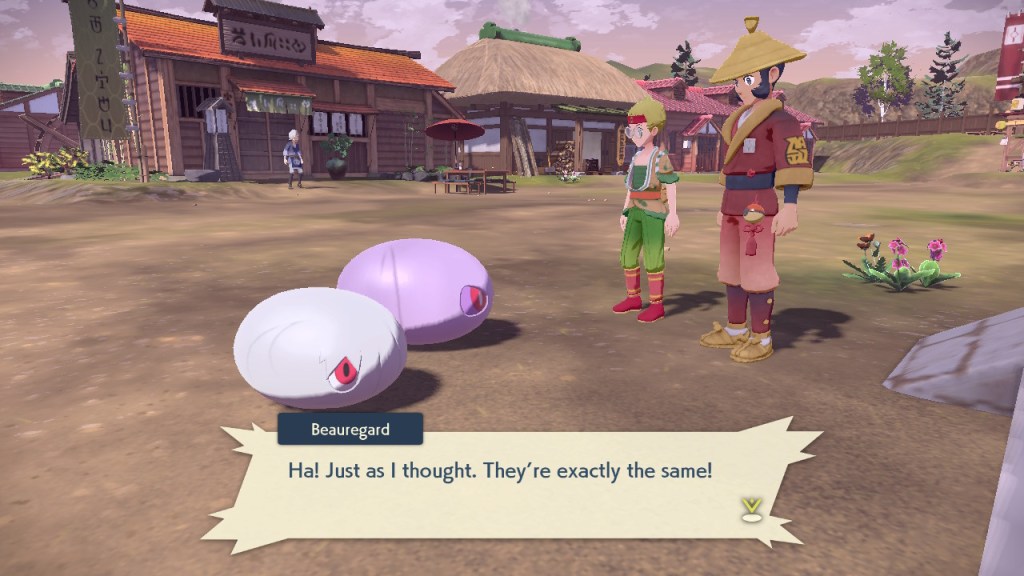
I can’t help you
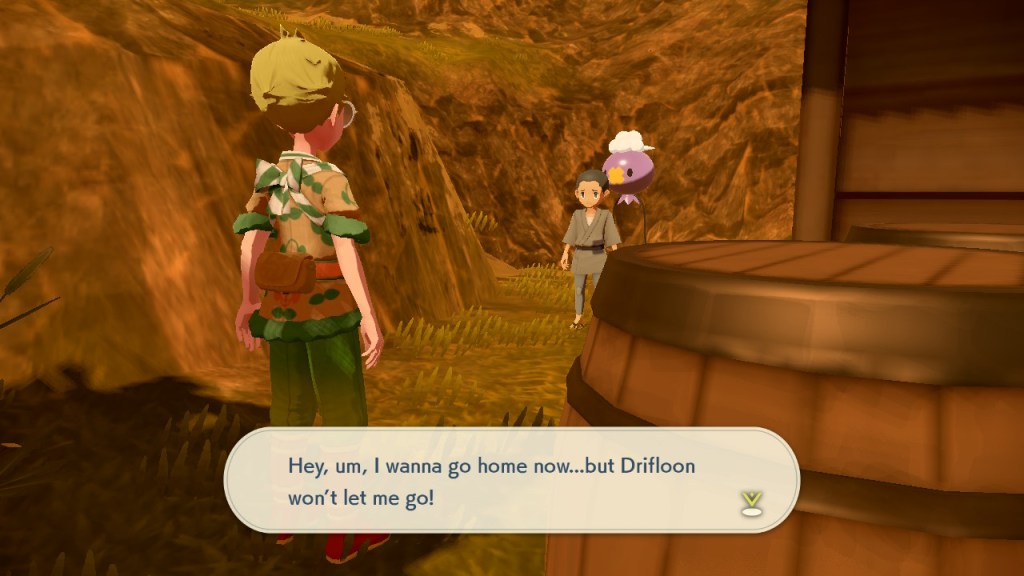
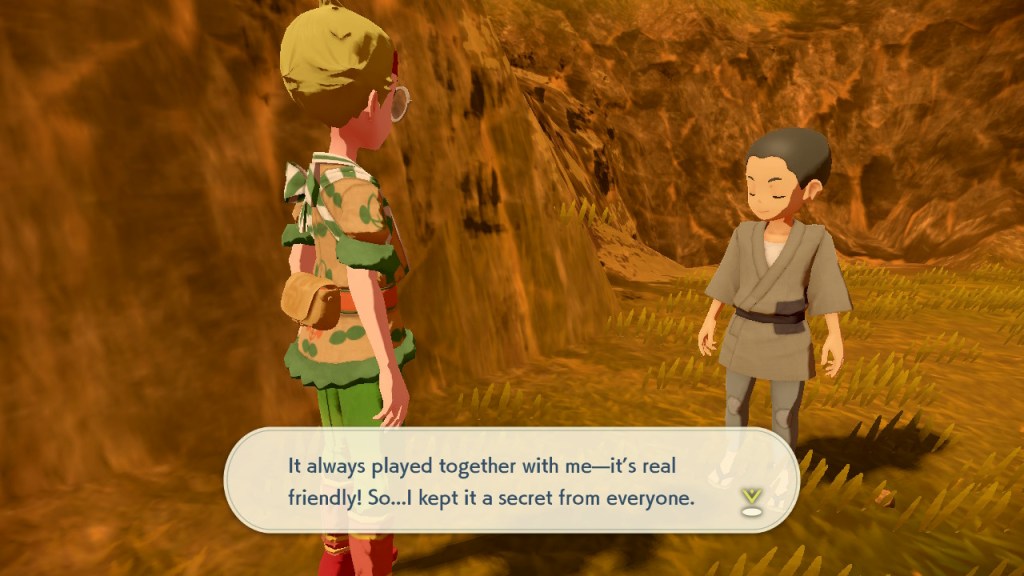
More fun worldbuilding and background character stuff – there’s a quest about a Drifloon that’s supposedly been playing with village children, which should ring alarm bells for anyone familiar with Drifloon’s Pokédex data. It turns out that one of the village kids has been playing with a wild Drifloon in secret, and now it isn’t letting him go home. He’s kept the Drifloon secret so far so it wouldn’t get in trouble, and even now he doesn’t seem all that upset with it – it seems to be a theme of this game that the settlers’ kids are a lot more willing to embrace Pokémon without fear than the adults are. I suppose that’s part of the reason Pokémon training is seen as such a normal thing for young children in later ages.

I love it when games include little details that show how your actions have made a positive impact on the world around you. There’s an earlier quest where you have to help out a member of the Security Corps with a group of Bidoof that are causing trouble in the village, but once you’ve rounded them up, the Construction Corps decides to let them stay and recruit them to help build up the town. And here they are!
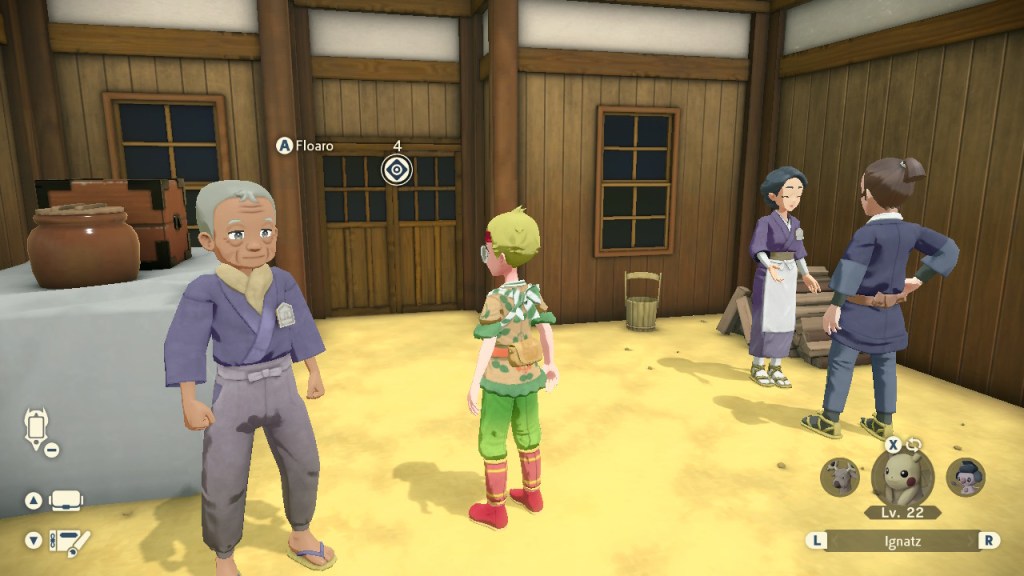
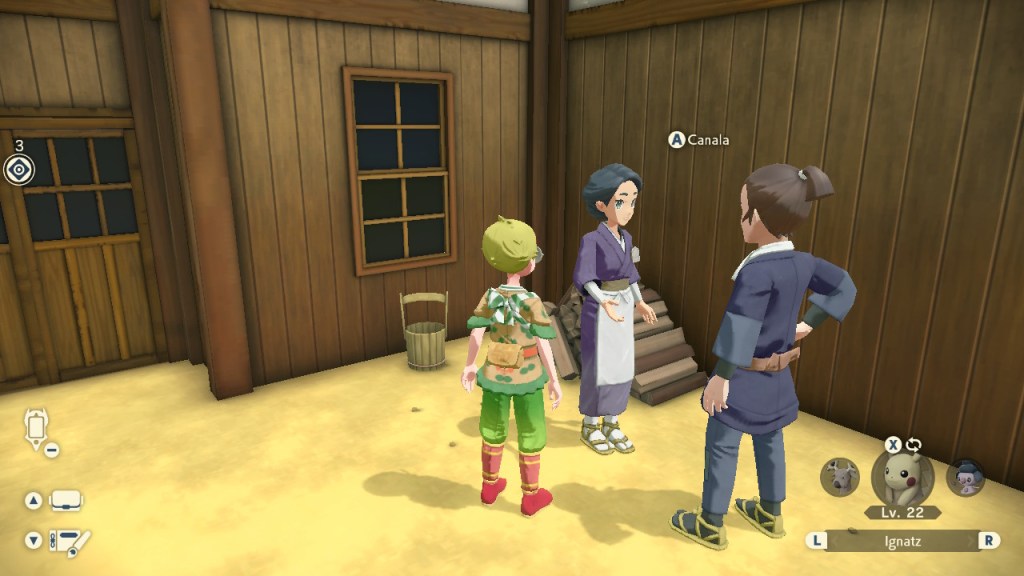
Okay, this is just weird. I mentioned in my first post on this game that the main streets of Jubilife Village are called Canala Avenue and Floaro Main Street, which I think are supposed to be the origins of the names of Canalave City and Floaroma Town. But where do the names actually come from? Apparently Floaro and Canala are just… the names of two random members of the Construction Corps? Maybe that’s just the kind of perk you get in the Construction Corps; when you help build part of a new town, it gets named after you. Streets and districts named after people are really common in real cities, of course; it’s just that in my experience all the best ones normally get hogged by political leaders, often not particularly deserving ones (I mean, I grew up in a city named after this bastard, who, as far as I know, never even set foot in New Zealand). Nice work by Floaro and Canala getting in on the ground floor!
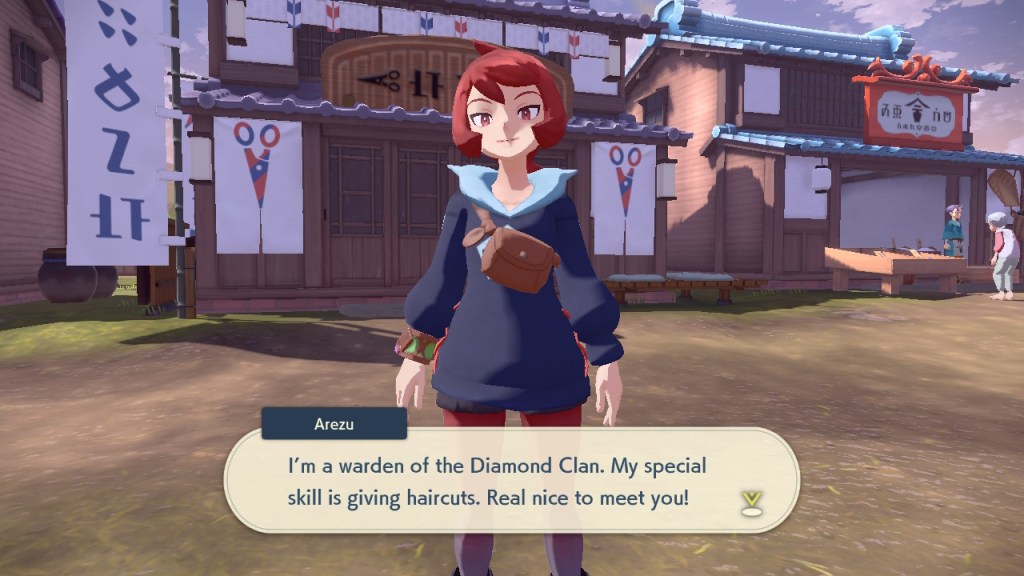
The next chunk of story comes to us courtesy of another Diamond Clan warden, Arezu, who has reported new disturbances in another part of Hisui, the Crimson Mirelands, to the Survey Corps and requested our help. Off we go!
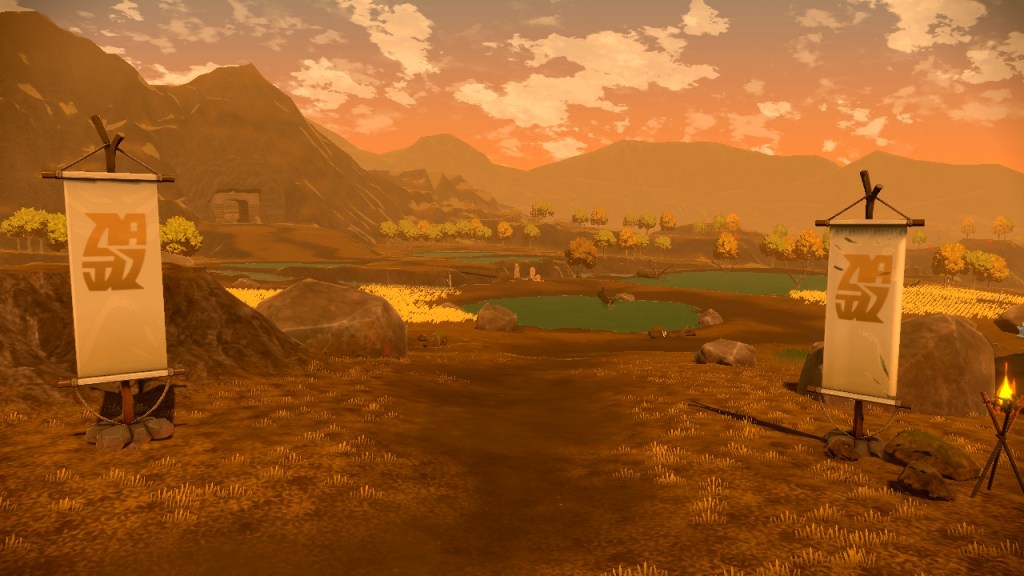
The Crimson Mirelands are on the other side of Mount Coronet in the southeastern part of Hisui, which will one day be the location of Hearthome City, Solaceon Town and Pastoria City. In modern Sinnoh, most of that sub-region is very wet and marshy, and it was apparently even more so in the 19th century. Because we’re now in a different biome, there’s a whole new selection of wild Pokémon to catch and learn about – Budew, Psyduck, Carnivine, Hippopotas, Croagunk, Yanma, lots of Pokémon based on plants and animals that live in wet areas.
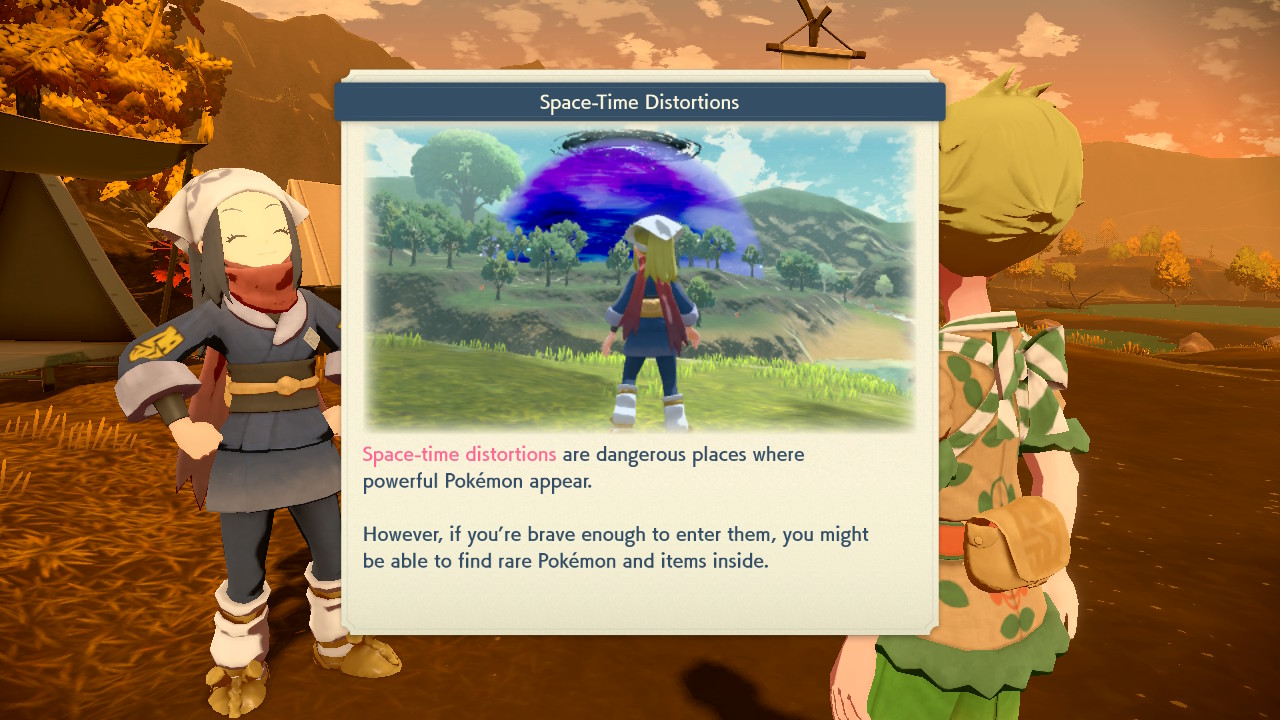
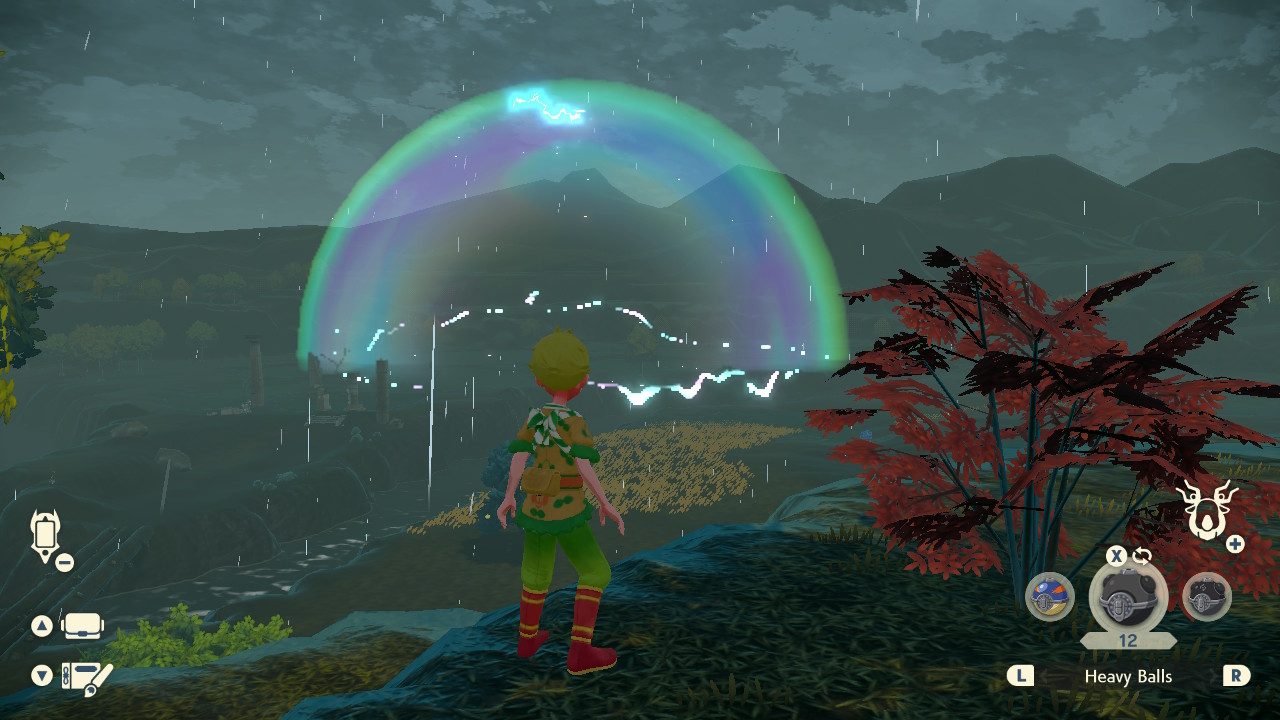
We’re also apparently going to start seeing “Space-Time Distortions.”
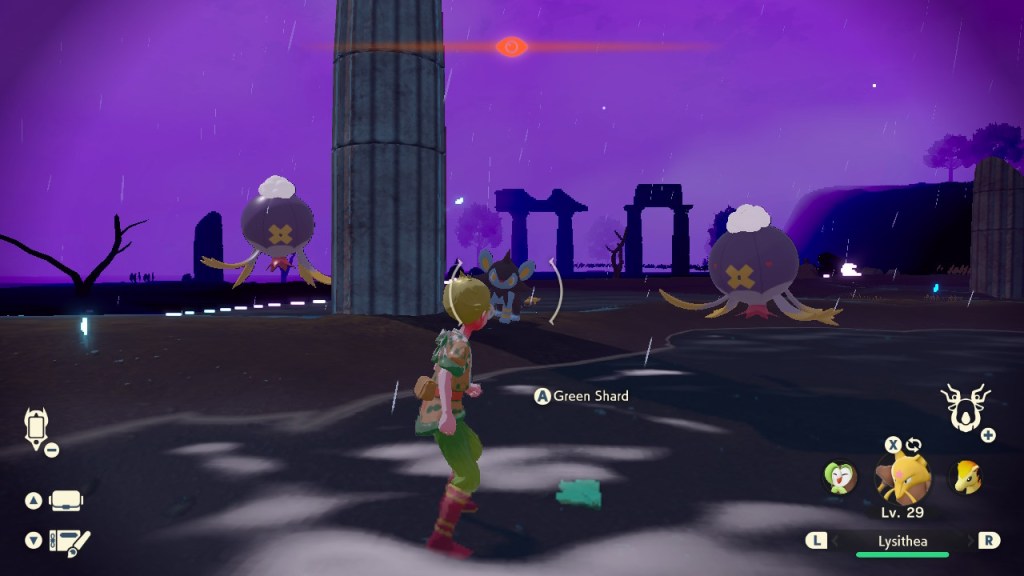
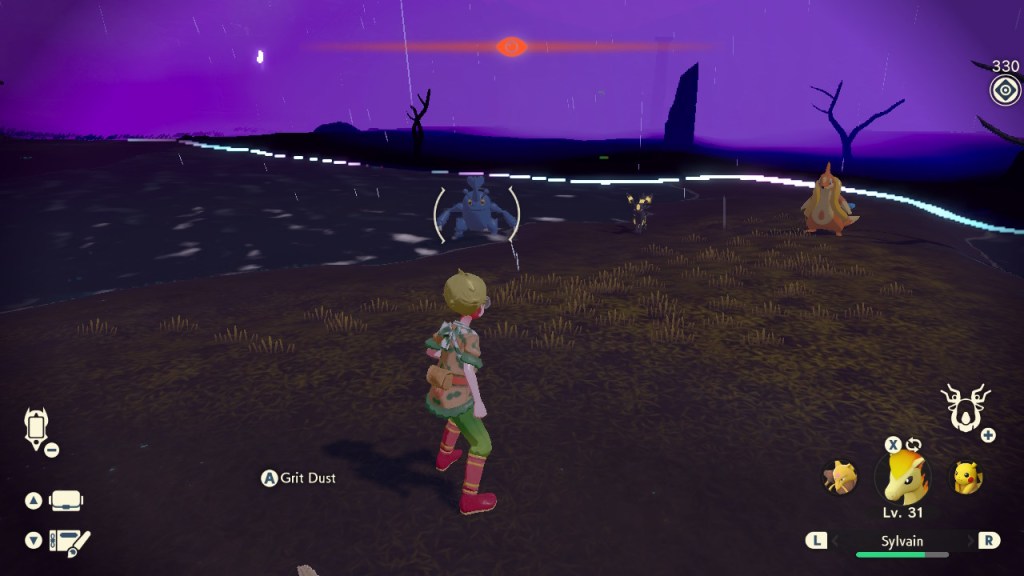
These are, as far as I can understand it, magical wonderlands where angry Pokémon from the future appear out of nowhere and try to murder you, often three or four at once. How do I know they’re from the future? Well, the name “Space-Time Distortion” is arguably something of a giveaway, but also…

Because this fµ¢£er is here, and if that doesn’t prove that Skynet is trying to meddle in the history of Sinnoh, I don’t know what will.
Space-Time Distortions are very dangerous because of everything trying to kill you, but they’re also an opportunity to catch some rare Pokémon, and they also seem to deposit a lot of valuable items that you can pick up, like Nuggets and coloured Shards (in previous games these have been a currency for paying move tutors; I don’t know whether they’ll have a similar purpose in Hisui, but it’s a good bet that collecting a lot of them will be useful later).

Like the Obsidian Fieldlands, the Crimson Mirelands are dotted with ruins of some past civilisation, although the Mirelands have a lot more of them. The aesthetic is definitely Roman-inspired, like the ruins we saw at the Spear Pillar back in the original Diamond and Pearl (the fluted Doric columns in white limestone can be Roman or Greek, as can the triglyph decoration on that architrave, but I think the archways say Roman). I wonder if there’s anything to find here by mapping out the locations of all the ruins and trying to “link up” the remains that could belong to different parts of larger buildings…
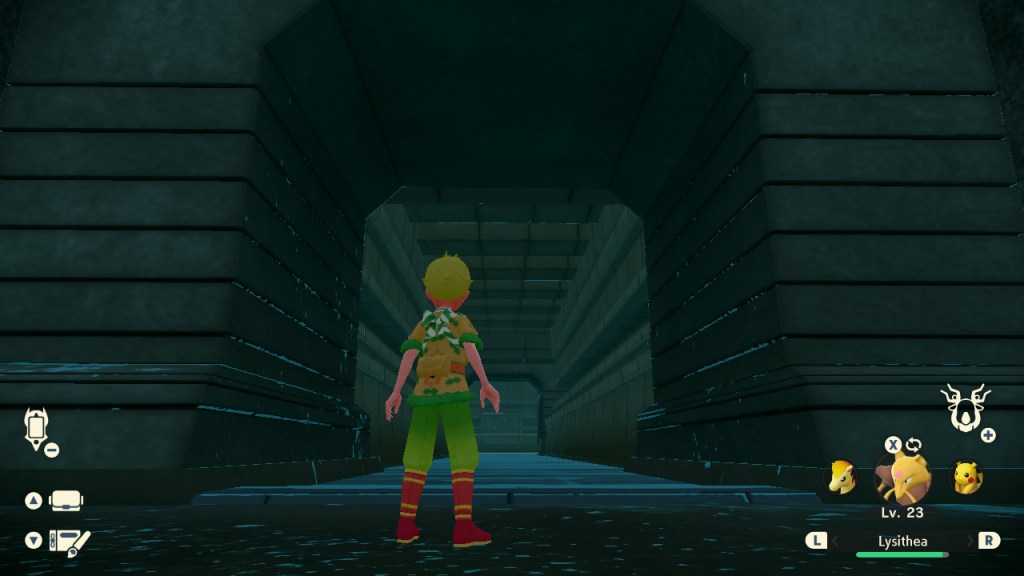
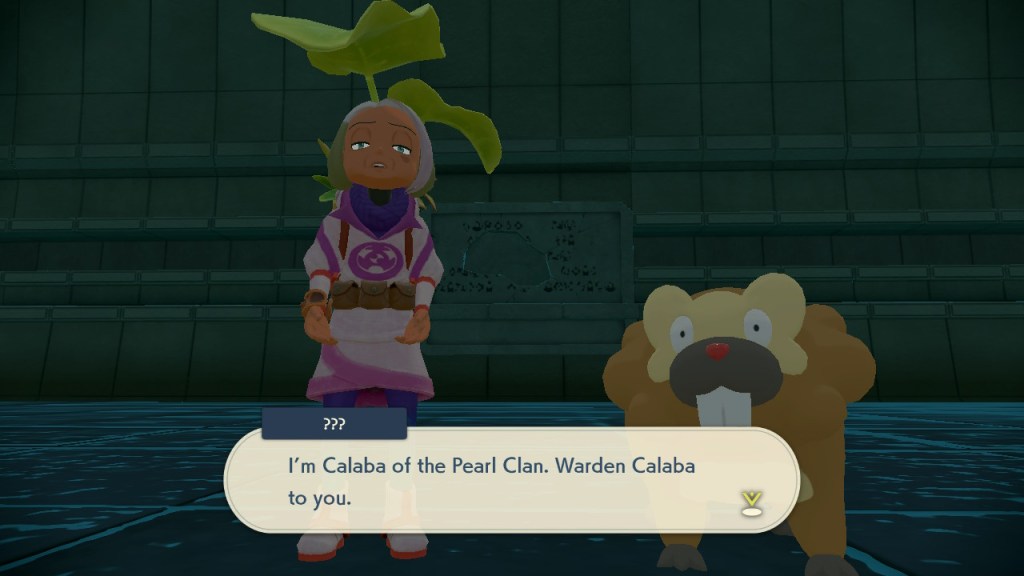
Anyway, our first errand is supposed to take us to the Solaceon Ruins to meet Calaba, an elderly warden from the Pearl Clan who is responsible for Ursaluna, another noble Pokémon who seems to have been disturbed by recent events. According to other characters, Calaba is one of the most rigidly traditional of the Wardens of either clan, and intensely distrustful of both the Diamond Clan and the Galaxy Team. To be honest, I don’t think she’s particularly unreasonable once you get to know her, but she’s particularly unimpressed by the way we dealt with Kleavor, which she describes as “bullying a Pokémon into submission,” and isn’t initially willing to even admit that she needs help – with Ursaluna, or with the unrelated problem that has brought her to the ruins. According to Volo, an important stone inscription has been vandalised, and recovering the stolen piece would go a long way to winning Calaba’s trust.
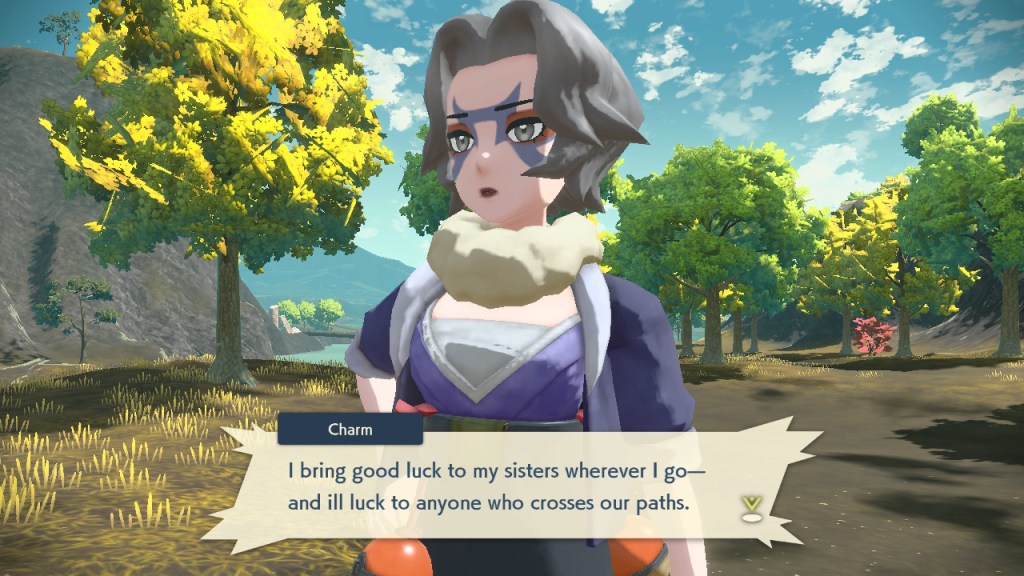
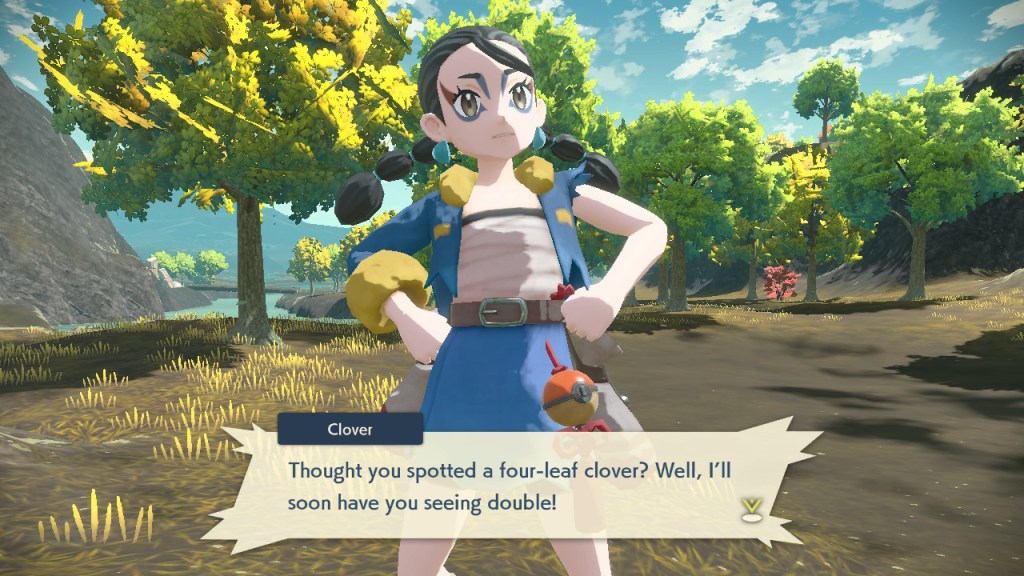

The culprits are the Miss Fortune bandit sisters, Charm, Clover and Coin (themed names, all linked with luck). It seems like these three are going to be recurring antagonists, and maybe we’ll learn more about what their deal is later on, but for now they’re just in our way.
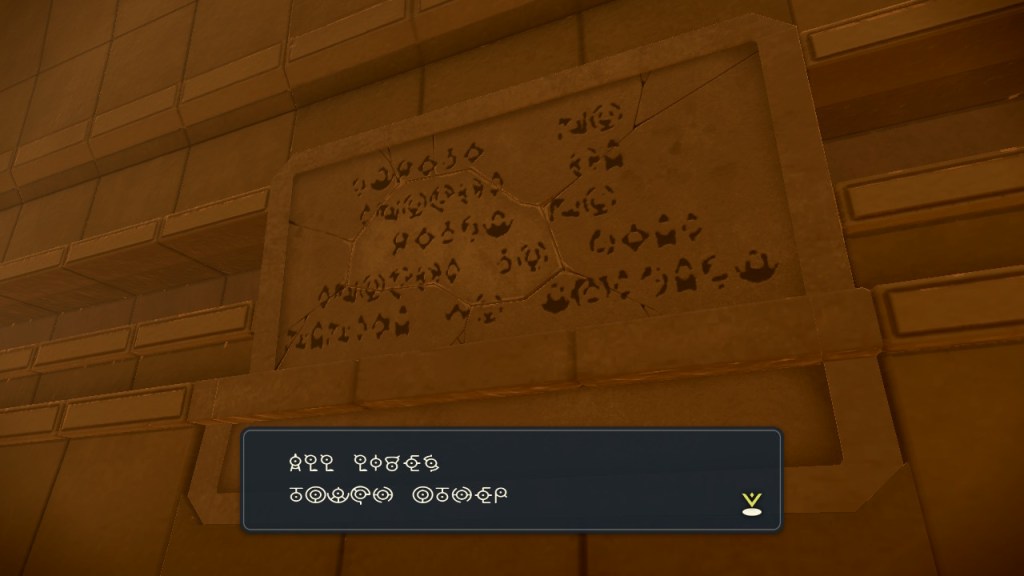
The restored inscription is the same one we can read in the Solaceon Ruins in the present day, on Diamond and Pearl: “Friendship: All lives touch other lives to create something anew and alive.” Maybe re-reading that inscription has some impact on Calaba, because she’s now willing to ask us for help with her enraged noble Pokémon, Ursaluna.
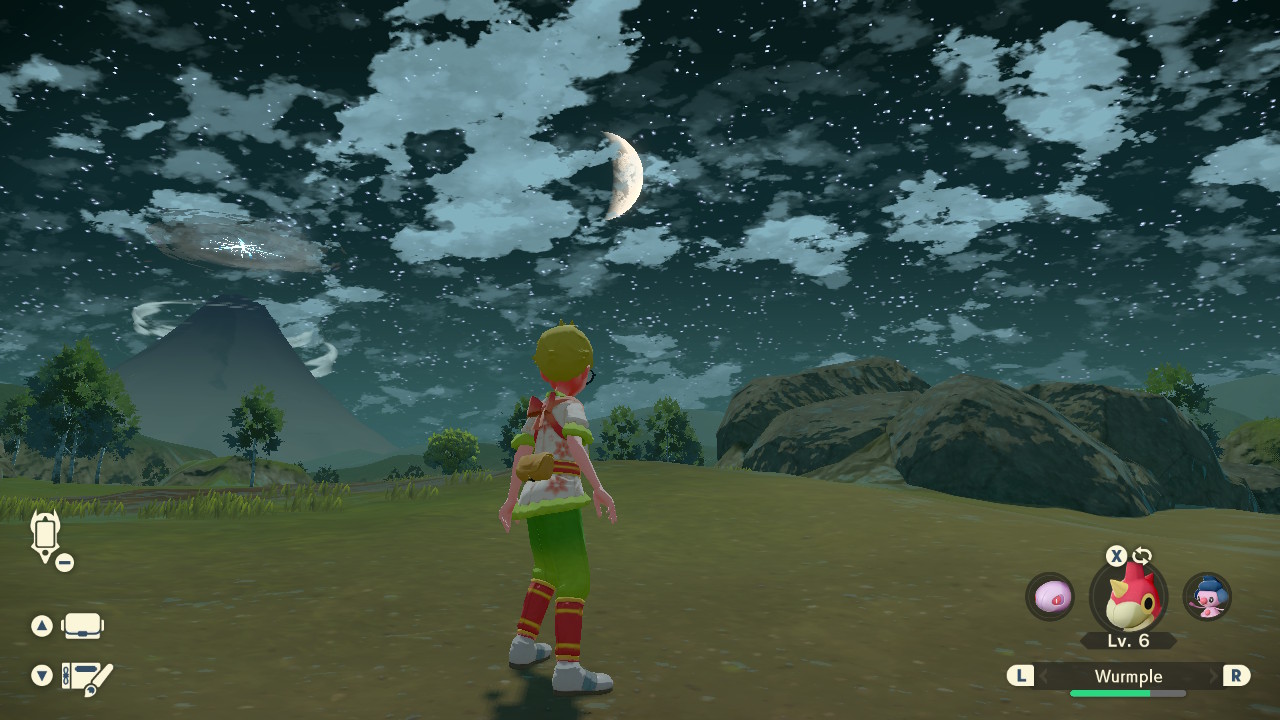
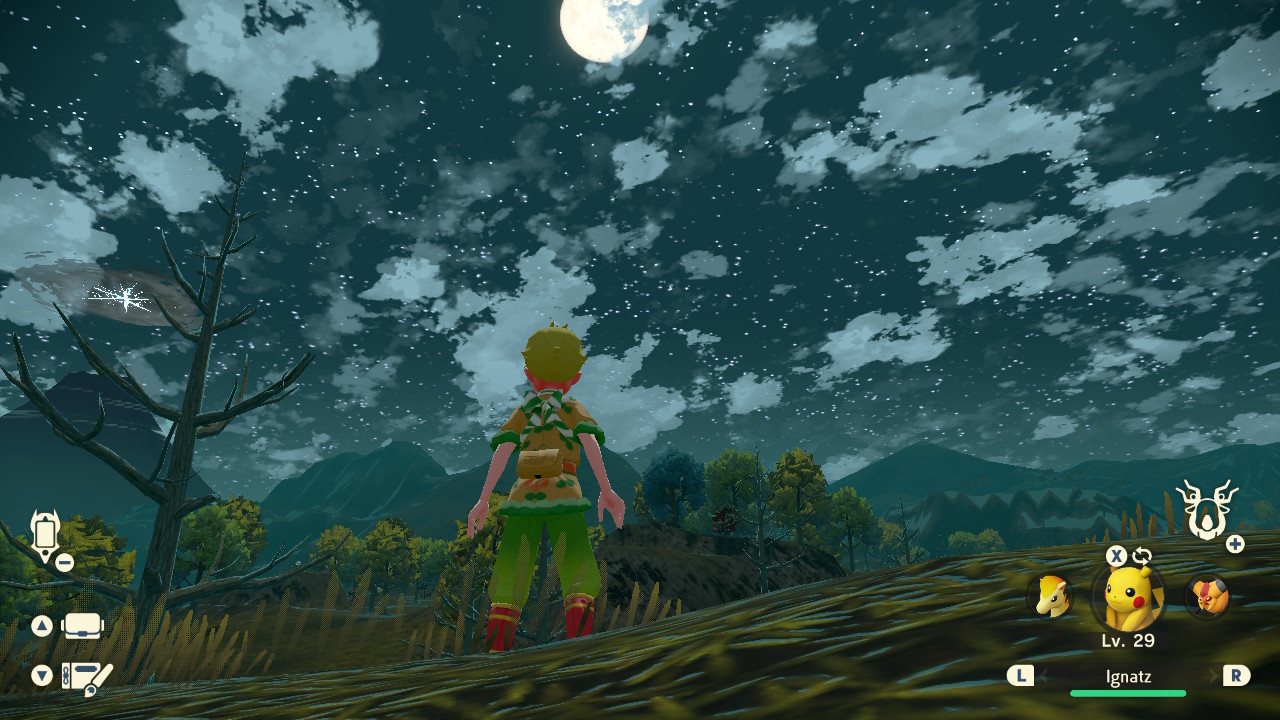
The moon seems to have different phases in this game. That’s probably not important; I just think it’s a nice touch.
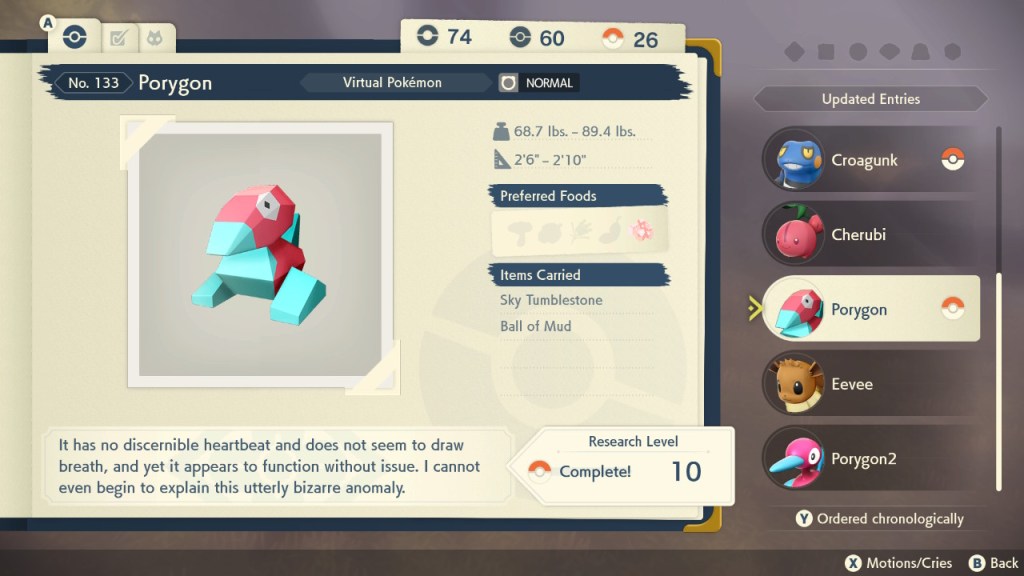
yeah, honestly man I dunno what to tell you either
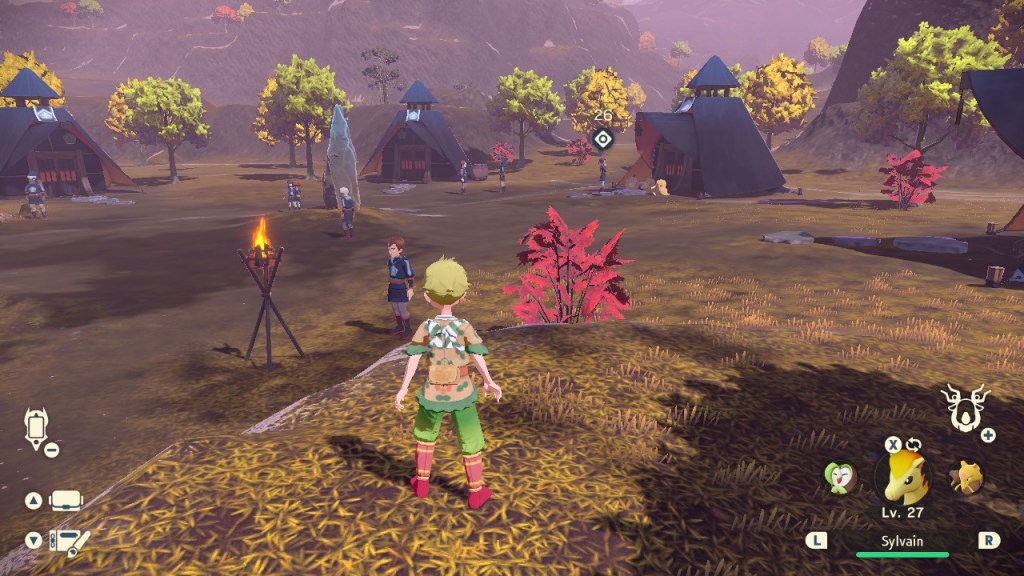
The Crimson Mirelands are apparently the location of the Diamond Clan’s village. Adaman isn’t here right now, but his people are happy to chat.
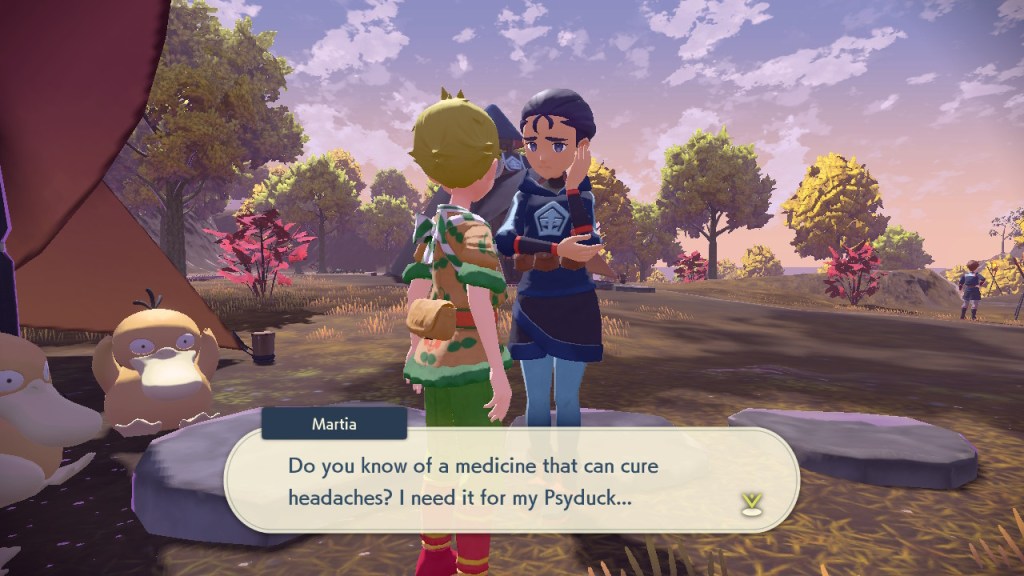
Ohhhh no you don’t. I’ve been down this path before. Get your own damn Psyduck medicine.
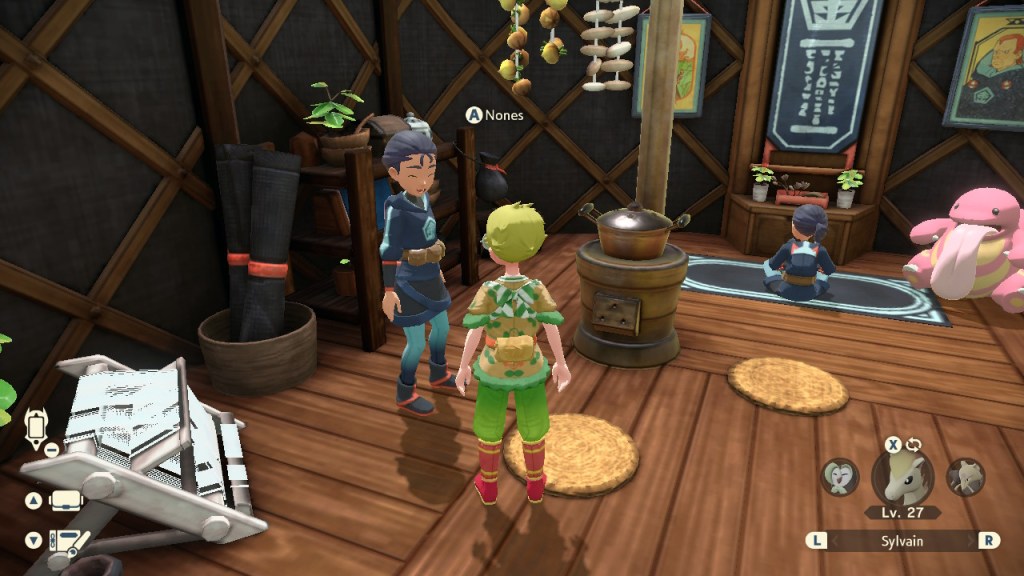
One small thing I really like about the Diamond Clan is that they all have names related to time, calendars and chronology. These two, for instance, are Nones and Ides, referring to dates in the ancient Roman calendar (as in “beware the Ides of March”). One of the kids outside is Cember (as in December), an old man is Alman (almanac), there’s an Era, a Minit, a Peren (perennial), an Aetas (Latin for “age,” “era” or “generation”) and a Kron (from the Greek for “time”). They worship time, so I think it’s kinda cute for them all to have these themed names.
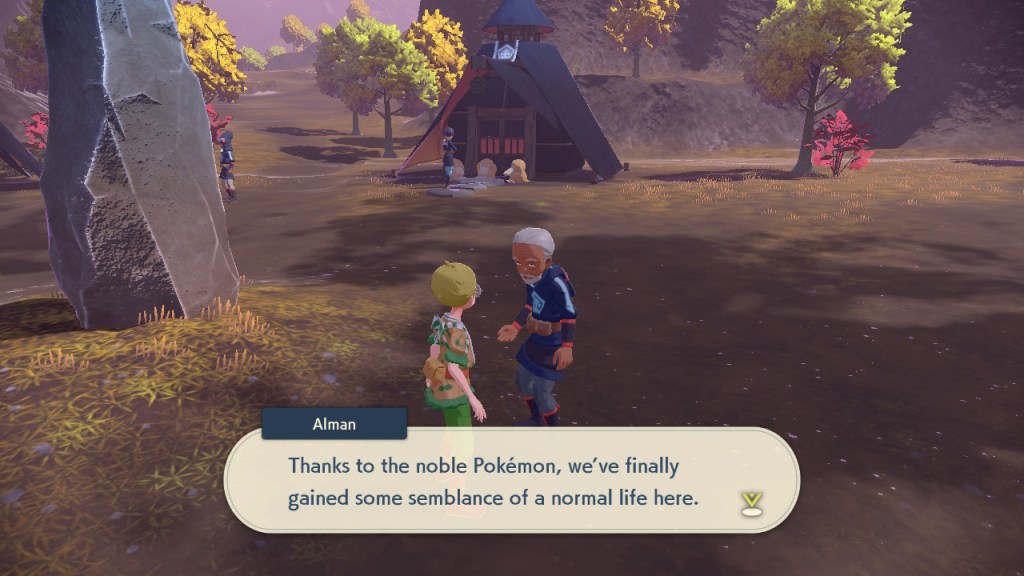
I think what Alman means here is that the noble Pokémon are able to mediate between the humans of the Diamond and Pearl Clans and the often aggressive wild Pokémon of Hisui. The relationships between the Wardens and their nobles aren’t just spiritually important, they’re actually essential to the physical safety of their settlements. Jubilife Village has walls, guard towers and an entire Security Corps to prevent angry wild Pokémon from giving the settlers grief – the Diamond and Pearl Clans don’t have to spend that amount of resources because they use diplomacy and ritual to keep themselves safe.

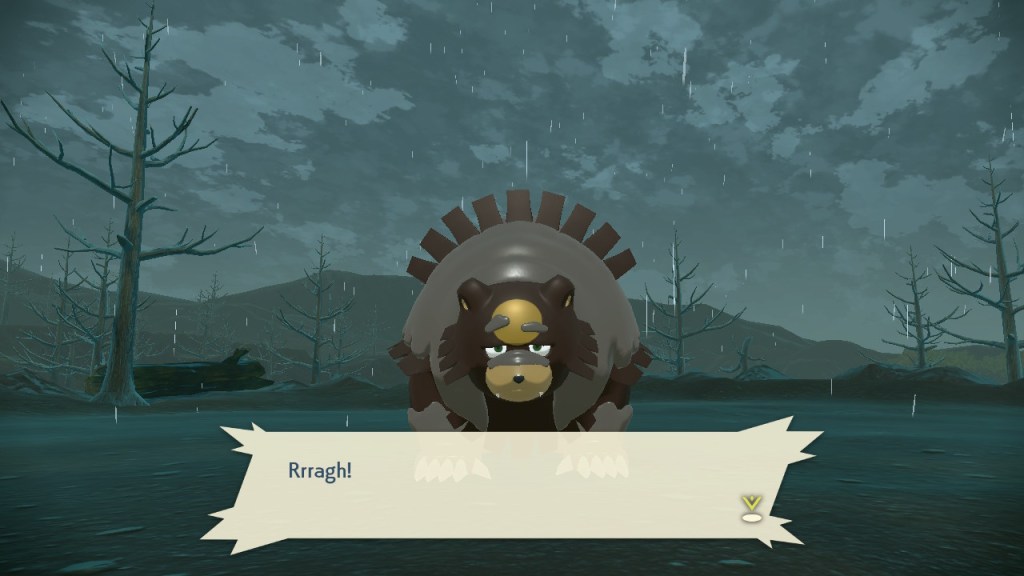
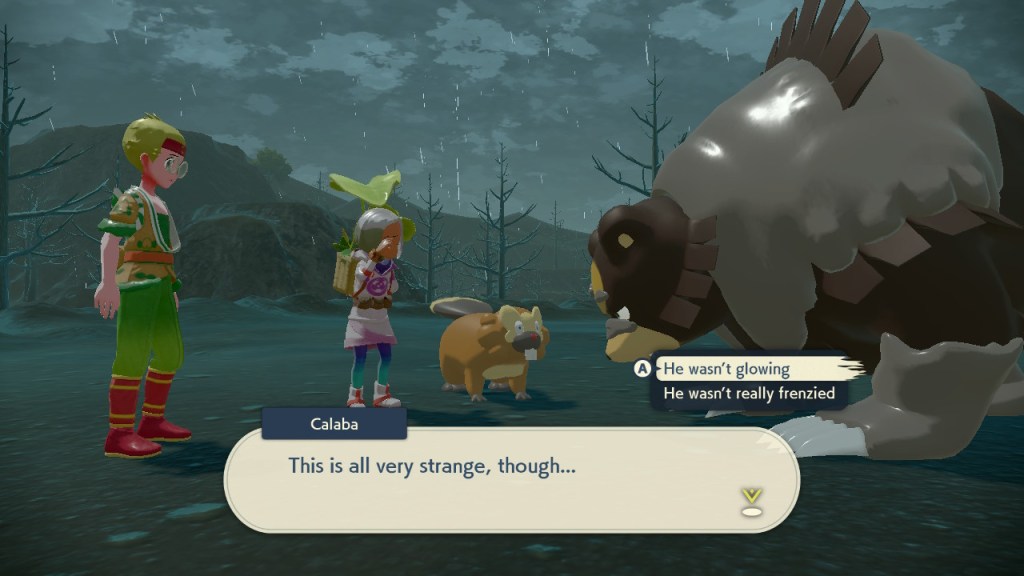

When we fight Ursaluna, he turns out not to have been in the same kind of mad frenzy as Kleavor – just pissed off about something in a fairly normal way. That makes this a perfectly normal battle, after which Calaba tries giving Ursaluna a powerful antitoxin, which seems to clear his mind. She also finds a strange powder on Ursaluna’s fur, and suspects that Arezu tried to poison him.


Now that we’ve visited the Solaceon Ruins, we can also find Unown – there’s one right here in Ursaluna’s arena. They don’t act like normal Pokémon, remaining perfectly still in their hiding places and neither attacking us nor running away, and they don’t just hang out in the ruins either. We seem to have some inscriptions giving us hints at where to find them all – these notes, if you can read the Unown script, say that the A-Unown is “within the settlement where time rules,” which can only mean the Diamond Clan’s village. And, lo and behold…

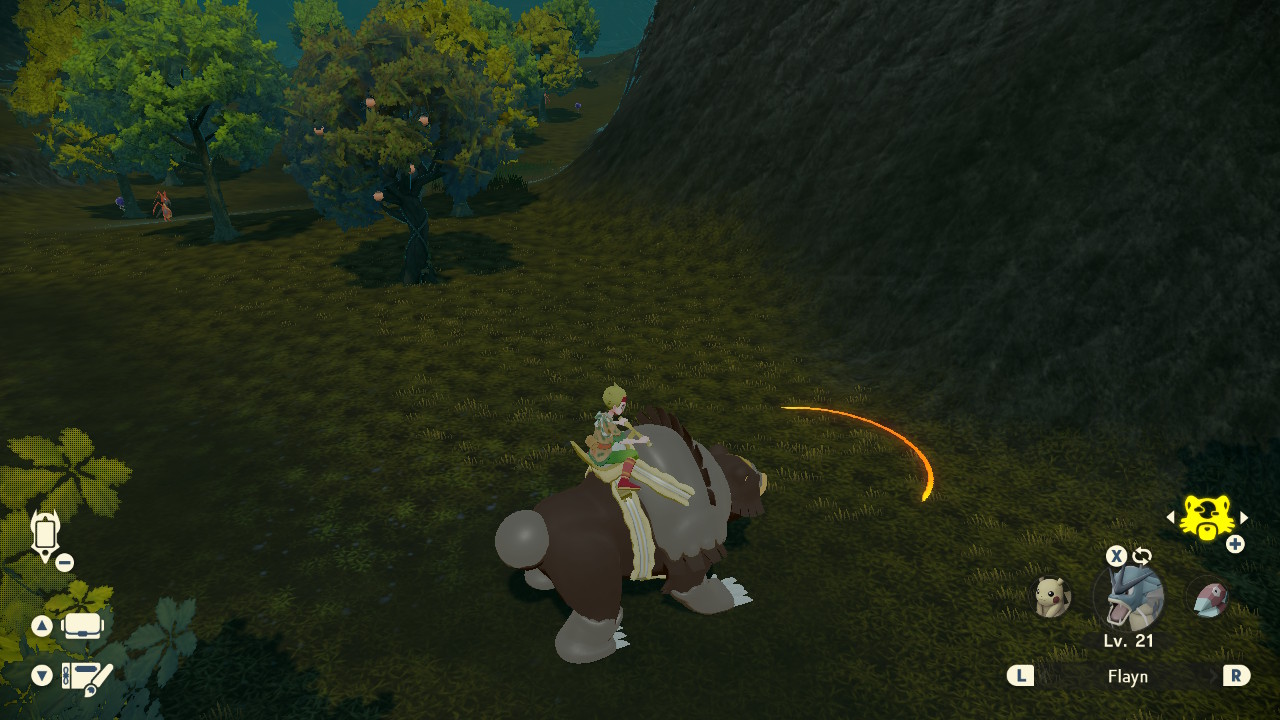

Having helped Ursaluna to calm down and won his favour, we can now use our magic flute to summon him just like Wyrdeer. Ursaluna is slower than Wyrdeer and can’t jump, but his keen sense of smell lets him act as an Itemfinder, helping us to find spots where we can dig for treasure.
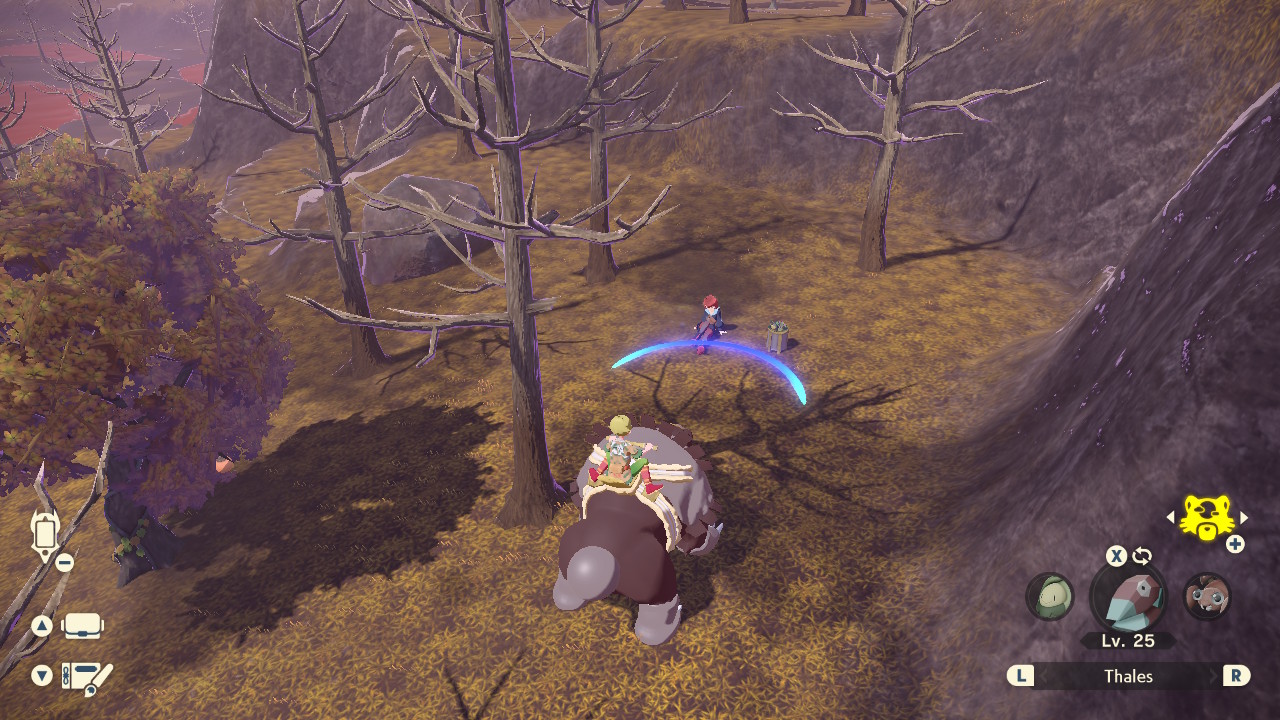

With Ursaluna’s help, we can track down Arezu, who has been injured while exploring the Crimson Mirelands. Calaba realises that Arezu got involved with Ursaluna and pulled the Galaxy Team into it because she was trying to help both Ursaluna and Lilligant, who is one of the noble Pokémon affiliated with the Diamond Clan and experiencing the same frenzy as Kleavor. The powder that Calaba found on Ursaluna was Lilligant’s pollen, and sent him into a sort of second-hand rage. Arezu (who I think is Lilligant’s own Warden) felt responsible. I think this is a really important moment for Calaba, realising that Arezu was trying to do something to help the Pearl Clan and their noble Pokémon, and seeing that maybe Arezu and the Diamond Clan are worth trusting a little more than she’s used to thinking. There’s a lot of hints in the story so far that we’re maybe progressing towards a resurgence of tensions between the Diamond Clan and Pearl Clan, perhaps even to the point of open conflict, which the Galaxy Team would like to avoid. Let’s hope helping Lilligant can move us in the right direction…

That moment you read something that makes you laugh but you can’t say anything because spoilers!
But also I had the same reaction with Beauregard. “They’re the same.” Bro, they’re different colors and their eyes are entirely different. I don’t know what to tell you.
LikeLiked by 1 person
I think I know what made you laugh, because someone has informed me that the moon actually *does* matter…
LikeLike
On the nose there
LikeLiked by 1 person
Pokemon has traditionally not been designed to have what we’d typically consider “boss fights” and they seem to have recently realized that this is a problem they want to solve.
LikeLiked by 2 people
Two hidden stuff sub-quests, Unown and wisps, seems kinda of a stretch (particularly with this game terrible drawing distance). But whatever it takes to extend play time, I guess.
LikeLike
Idk, the Unown one is more of a scavenger hunt, since it tells you where the Unown is hiding – plus 28 “things” isn’t much. The clues are all so obvious that none should take more than a few minutes.
The wisps are a bit more annoying since afaik there’s no way to know if you’re near one without seeing it, draw distance is bad, and many only appear at night. But I take solace that there’s only 107 and no more than 20 in an area (which the game tracks) – it’s not nearly as bad as BotW’s Korok seeds.
LikeLike
1. Looking at Kleavor makes me ache. Specifically in my wrists, elbows and rotator cuffs. It’s like Conkeldurr. And its body doesn’t look heavy enough to make ergonomic use of those axes. Now my lower back aches too.
Not a major gripe, I don’t think Pokémon need to make sense, but certainly my first impression of Kleavor’s design.
2. I checked out the battle on YouTube to see if Kleavor makes more sense when you see it in motion and it’s not too bad. Also got to observe this mix of action and turn-based mechanics and it looks surprisingly flow-y, though that’s hard to determine without actually playing the game.
3. I dismissed Ursaluna as “pointless, bleh” out of habit when I skimmed Serebii’s datamine; looking at the screenshots here I have to say that was unfair of me. Were it to follow Coco Chanel’s advice it would probably get rid of those two spots of clay(?) on its forehead, but otherwise I find it a straight up improvement on Ursaring. Love the hunched quadrupedal shape.
Giving bears some prominence in a region based on Hokkaido is also… neat?
4. Some newfound appreciation for Bibarel as well – that vacant stare and goofy grin is hilarious justaxposed to this giant bear with what looks like knives on its paws.
5. I suspect they selected the word “balm” because it’s sort of a pun on “ball”.
6. Thinking about it, Kleavor’s a Bug-type and insects are famously “strong”. So, well, probably unintentional (since this isn’t an ant or beetle Pokémon) and still very achey but that’s so brilliantly Pokémon.
LikeLiked by 2 people
There’s also the fact that Keavor is presumed extinct in the modern day…
LikeLike
I can confirm the action fights *are* flow-y. In fact, my only gripe there is they are few and far between, and they’re some of the most fun moments of the game. Admittedly, if I want an action game I wouldn’t be going to Pokemon, but I still have fun with those segments and wish they weren’t just one and done fights.
I haven’t gotten used to Kleaver but Ursaluna grew on me.
LikeLiked by 1 person
Luckily you can rematch them as many times as you want in the post game 83
LikeLike
I can’t IMAGINE the temporal chaos having the Porygon line arriving in the past is gonna have. Though this does feed well into my “Pokémon are constantly rewriting Earth’s history” theory XD
LikeLiked by 2 people
Oh yeah, I also never noticed that the Diamond Clan’s names were so well themed, neat! X3 I wonder if the Pearl Clan has equally nice theming, maybe for geography and measure units of length?
LikeLiked by 1 person
Yeah, I haven’t found their village yet but I’m interested to see; I’m also betting on a measurement theme.
LikeLike